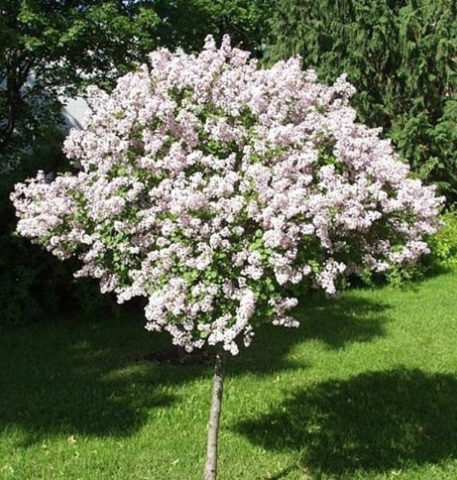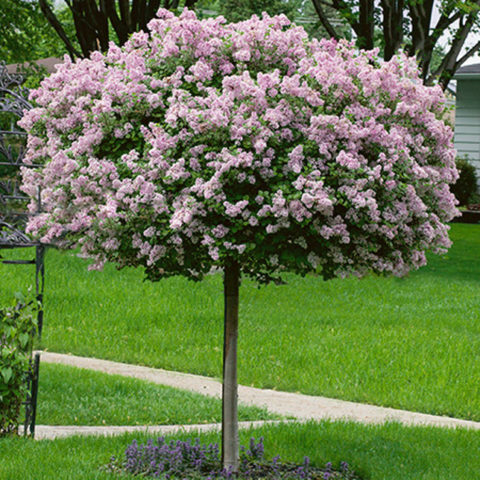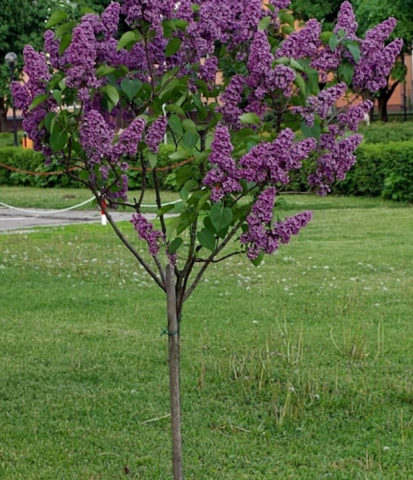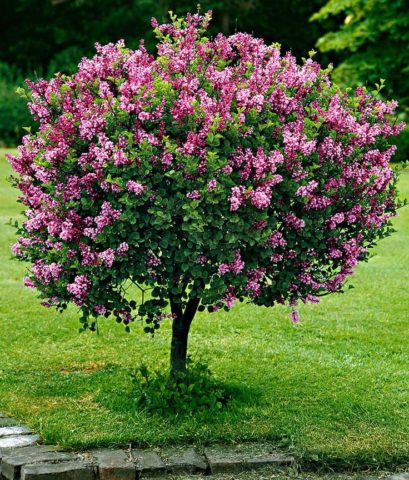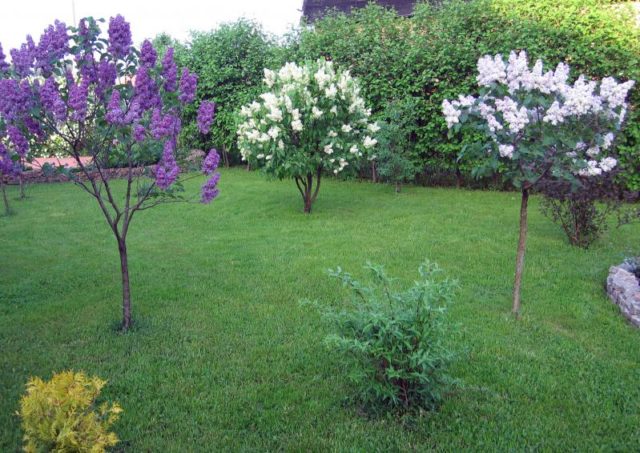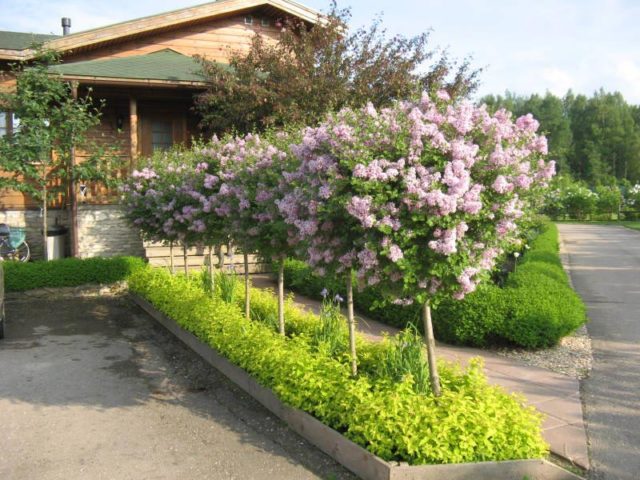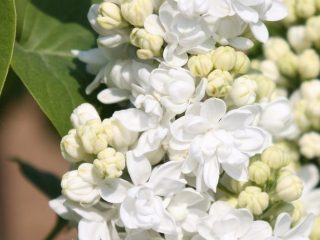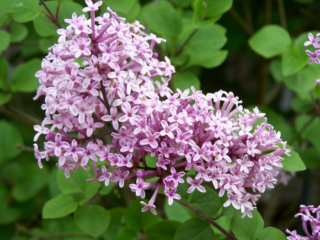Content
- 1 What is a lilac on a tree trunk?
- 2 Advantages of growing standard lilacs
- 3 Varieties of lilac on a trunk
- 4 How to make lilacs on a standard with your own hands
- 5 How to make a standard tree from a lilac using grafting
- 6 How to form a lilac on a trunk without grafting
- 7 Planting and caring for standard lilacs
- 8 Conclusion
Lilac on a trunk is not a separate variety, but an artificially formed decorative tree of compact size. Ordinary lilac is a multi-stemmed shrub. Standard lilac has a single trunk and a round, even crown. This form is well suited for various types of gardens, including small areas.
What is a lilac on a tree trunk?
The trunk is a part of the trunk without branches, which is located from the root collar to the beginning of branching. The trunk is about 1 m. Further, a compact crown is located on it.
Lilac tolerates pruning well, so it allows you to create different crown shapes. The photo of a lilac on a trunk shows that the plant blooms profusely. A new variety or several different ones can be grafted onto the trunk of one crop, resulting in one tree blooming in different shades.
A grafted lilac on a trunk does not require constant removal of side shoots, unlike a self-formed one. But the roots of a tree grow over a longer period. Some varieties of standard lilac can be used as a potted plant.
Advantages of growing standard lilacs
Without shaping and pruning, the lilac bush grows and becomes unattractive, and flowering weakens. With proper care, a standard plant blooms profusely, looks well-groomed and original. Typically, a standard tree is formed with a small, rounded crown. You can grow lilacs on a trunk in the bonsai style or intertwine young branches to get unusual branches.
Compact standard plants do not take up much space in the garden; they look neat and decorative when planted in groups or alone. Standard lilacs decorate alleys and the periphery of plots. Trees combine more successfully with other plants than bush forms and serve as the background for mixborders. Lilac, like a standard tree, is decorative not only during flowering, but also when left with only one foliage.
Varieties of lilac on a trunk
Lilac varieties differ in shades of flowering, size of leaves and flowers. Standard plants are distinguished by the intensity of annual growth and the size of an adult tree, by height and diameter.
Beauty of Moscow
Beauty of Moscow is an old variety, distinguished by its original double flowers and fragrant aroma.
As the tree blooms, the pink buds give way to pearly white flowers with a slight pink tint in the middle, transitioning to pure white at the end of flowering.
Meyer Palibin
One of the shortest varieties.The dwarf tree produces small annual growth and grows no more than 1.5 m in height.
Blooms profusely, with a pale lilac hue. Distinguished by repeated flowering at the end of summer.
Charles Joly
A fast-growing lilac with luxurious blooms. Small flowers are collected in clusters of dark purple color.
In adulthood, the plant forms powerful skeletal branches, as well as a dense leafy, dense crown. The leaves of the variety are medium-sized.
Katerina Havemeyer
The 1922 variety is distinguished by large, double flowers, lilac-pink in color and heavy, dense inflorescences.
From the photo of the standard lilac it is clear that Katerina Havemeyer is distinguished by its abundant flowering. The leaves of the variety are large. The variety has a rich aroma.
Ready-made standard lilacs on sale are not cheap. Depending on the variety and age of the plant, the price is 3000-8000 rubles.
How to make lilacs on a standard with your own hands
You can create a standard lilac using grafting or shaping. Dwarf varieties, as well as shrubs with a compact crown, are well suited for this purpose. But a standard tree can be formed on any lilac. Self-rooted plants withstand frost better.
How to make a standard tree from a lilac using grafting
To form a standard tree, you need a rootstock - the part of the tree on which the scion cutting will be grafted. Up to several different varieties of shrubs can be grafted onto one rootstock. In this case, the varieties must have the same flowering time as well as leaf size.
Instructions for making lilacs on a trunk with your own hands:
- Growing a rootstock. A shoot from any lilac can serve as a rootstock for forming a trunk. It is taken from the vegetative propagation of a bush, for example, by layering or cuttings. Dug up root shoots are also suitable. The resulting shoot is grown separately to a height of about 1 m. To prevent the fragile trunk from becoming bent, at first it is grown tied to a peg.
- Vaccination time. Vaccination is carried out during the onset of sap flow and for two weeks after it.
- Preparation of the rootstock. The day before grafting, excess roots are cut off from the grown shoot. To do this, they are cut off with a shovel in diameter at a distance of 20 cm from the trunk. The shoots that protrude beyond the soil are cut off with sharp pruning shears. The buds are removed from the rootstock. If additional vaccinations are planned in the future, a few buds are left on top.
- Vaccination methods. A varietal shoot is grafted onto a standard using budding with an eye or by the bark.
Later, when the grafted lilac grows together and the crown grows, it is formed by cutting off the branches to the required length. No side shoots are formed on the grafted lilac trunk, which makes caring for the tree much easier.
How to form a lilac on a trunk without grafting
You can grow lilacs on a trunk without grafting using a young bush. You can get a new bush from a planted shoot or use one already growing on the site.
To form a trunk, choose a central, even and strong shoot. To speed up its growth, the side shoots are cut off, leaving the central branch. Feed with organic or mineral fertilizers, water and mulch. It will take about 4-5 years to grow standard lilacs.
To support the trunk, as in the case of grafting, it is tied to a peg. 5-6 buds are left on top of the trunk, which subsequently form lateral branching and crown formation. When the side branches begin to grow, pinch them or immediately create the necessary shape.
The formed trunk is kept bare, removing excess shoots. You can also additionally graft another variety of lilac onto the resulting standard or leave only the initial one.
The crown of a standard tree must be thinned over time. For abundant flowering, dried inflorescences are cut off with a small part of the branch. In the first years of growing a standard tree, about half of the flowering clusters are also cut off in order to achieve more luxuriant flowering in the next season.
In order not to damage the formation of the crown, branches should not be broken off, and only sharp garden tools should be used to remove them.
Planting and caring for standard lilacs
Planting and caring for lilacs on a trunk is similar to caring for a conventional crop. A permanent place is chosen for planting, but an adult standard tree can be replanted.
For planting, choose a bright place; some varieties can withstand light partial shade. But the spectacular and rich flowering of the standard tree occurs only in well-lit, windless areas. The crop is undemanding in terms of soil composition, but prefers loose fertile soils with neutral acidity. Low lying areas and wetlands are not suitable places for cultivation.
Planting and transplanting are carried out on a cloudy day or in the evening.The planting pit is prepared 2 times the size of the root system. If planting is carried out on depleted soils or uncultivated areas, the hole is made even larger in order to change the soil composition to a more fertile and breathable one. Acidified soils must be deacidified in advance by adding lime or dolomite flour.
A hole is dug deep according to the size of the seedling and taking into account the drainage layer. The root collar of the plant is not buried when planting. A drainage layer is placed at the bottom of the planting hole. To do this, use pebbles or expanded clay. The soil for planting is mixed with fertilizer.
The plant is lowered vertically into the planting hole and the roots are straightened. The planting is covered with soil, carefully distributing it so that air gaps do not form between the roots and the roots do not dry out, then the soil is compacted.
After planting, an earthen roller is poured around the trunk, retreating 25-30 cm. This way, when watering, the water will not spread. A bucket of water is poured into the formed circle. Subsequently, the roller is compared with the general soil level. The soil around is mulched.
Caring for standard lilacs:
- Watering. Young plants need additional watering in the first half of summer, especially when there is a lack of moisture from precipitation during dry and hot periods. In the fall, with the beginning of leaf fall, the soil is abundantly recharged so that the plant prepares for winter.
- Feeding. For abundant flowering of ornamental trees, fertilizers begin to be used from the second year of cultivation. To do this, both organic and mineral fertilizers are added to the soil. The first feeding is carried out in early spring after the snow melts. At this time, fertilizers containing nitrogen are used. The next two feedings are carried out at an interval of 3 weeks.To do this, take herbal infusions, as well as infusions of mullein or ash.
- Mulching. It is useful to cover the soil under the tree with peat or tree bark. This allows the top layer not to dry out, remain loose and breathable.
- Removing root shoots. The resulting root growth must be cut exactly into a ring. A method in which after pruning there is no stump left, which only increases the growth.
- Trimming. Most lilac varieties grow quickly. The formed crown requires maintaining the height of the branches at the required level. In spring, remove all dry and broken branches. They also periodically remove thickening from the crown so that all flower buds have enough light.
In the first years of growing standard lilacs, in winter, care must be taken to ensure that fallen snow does not break the crown and the standard itself. The trunks are wrapped in burlap so that they are not damaged by frost damage.
Conclusion
Lilac on a trunk is a compact tree that will decorate a garden in any style. Any gardener can become the owner of a tree with an exquisite silhouette. The process of creating standard lilacs with your own hands is simple and exciting, but it takes some time. In addition to its decorative function, a lilac fence traps dust and cleans the surrounding space.

